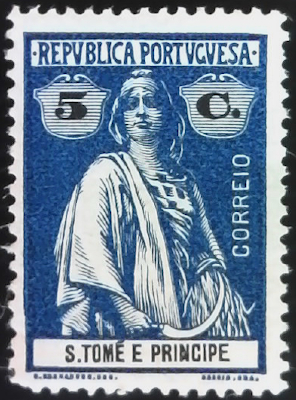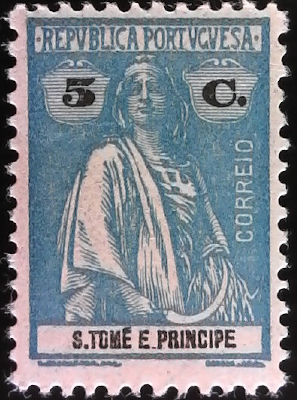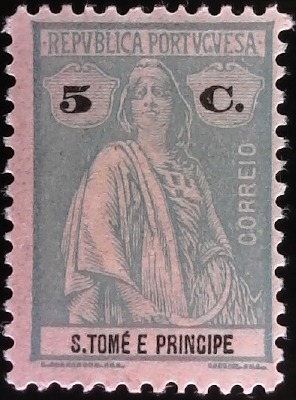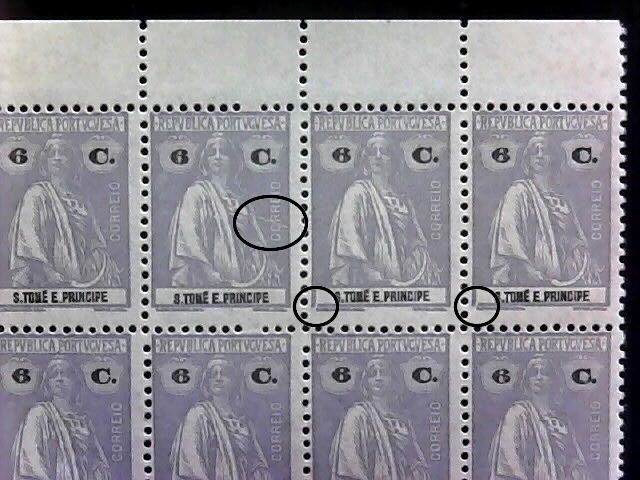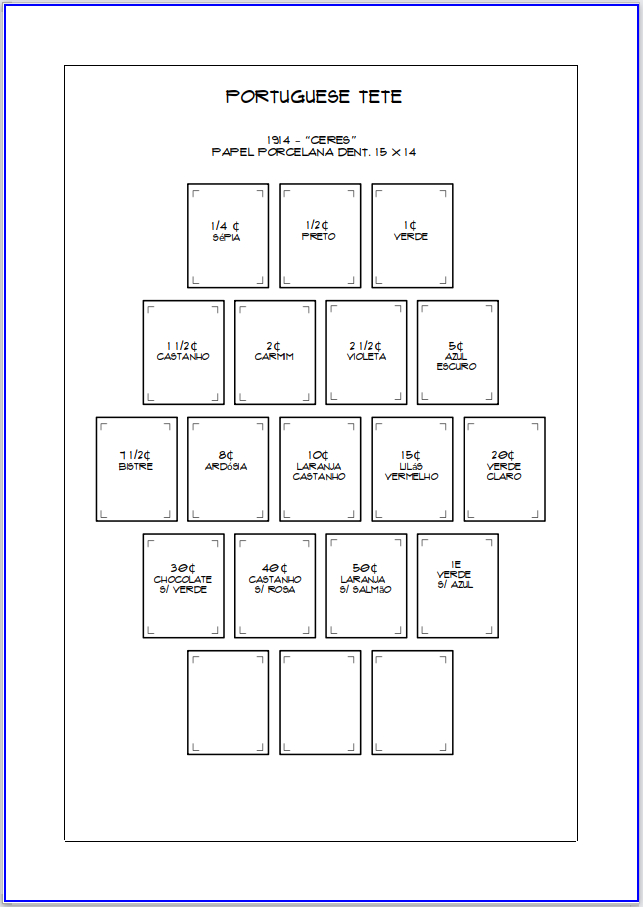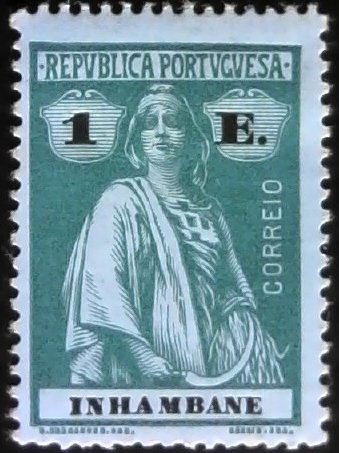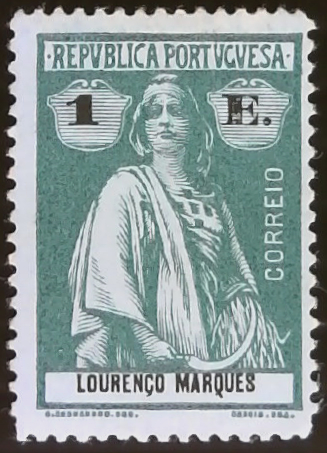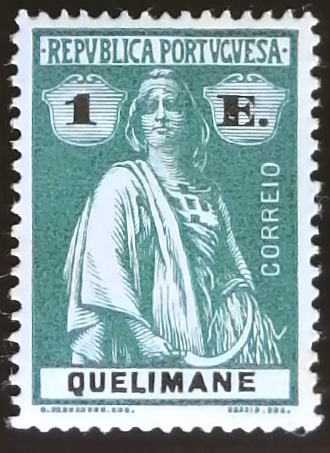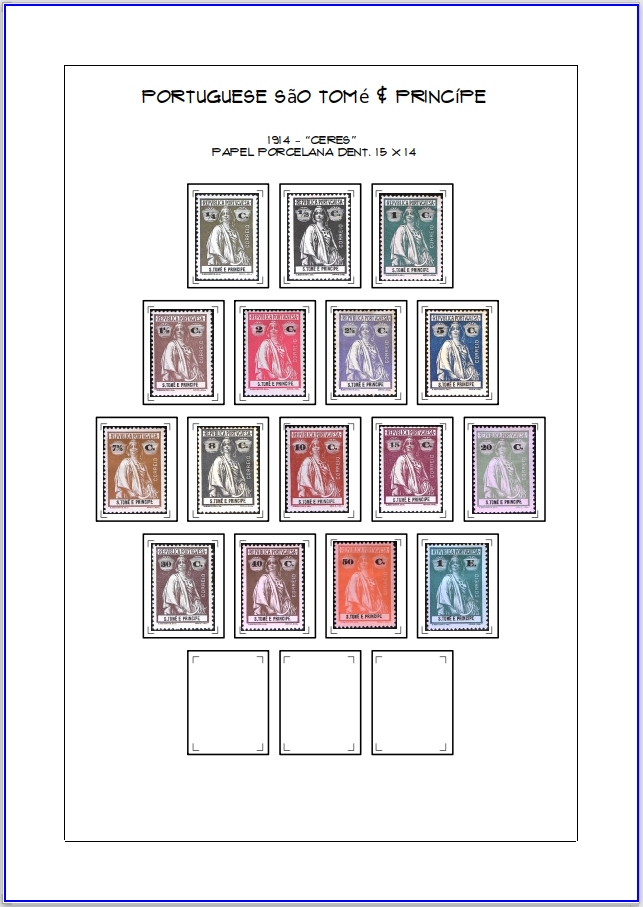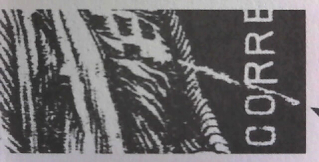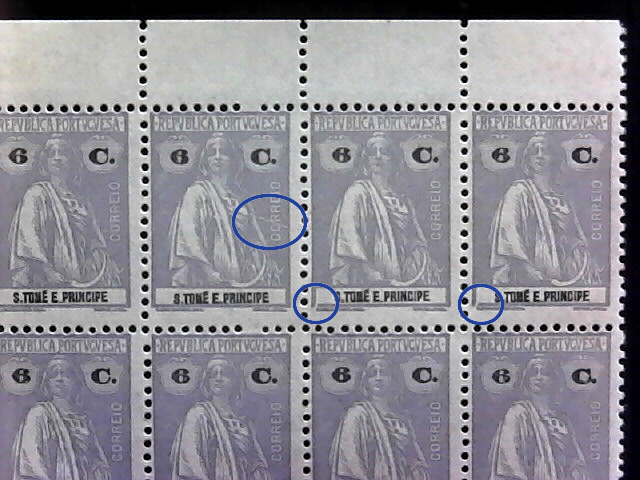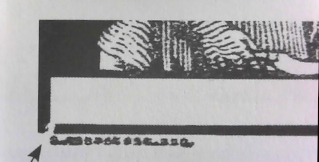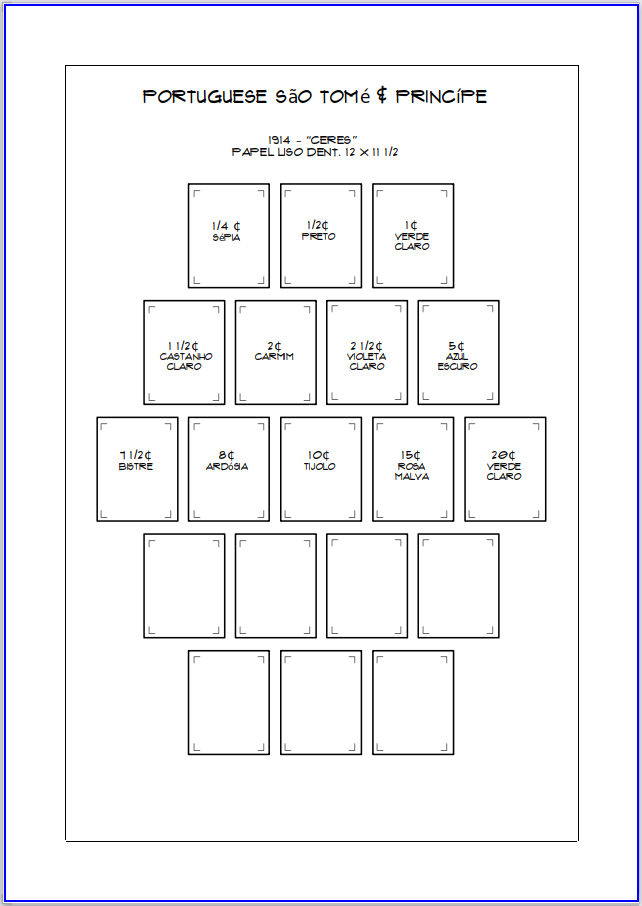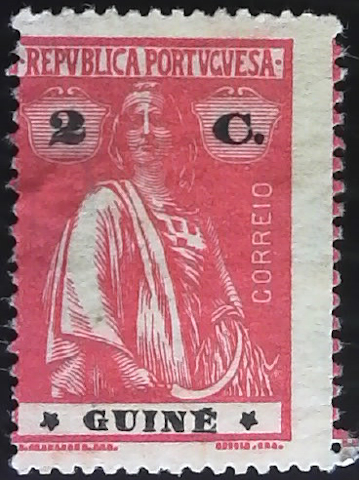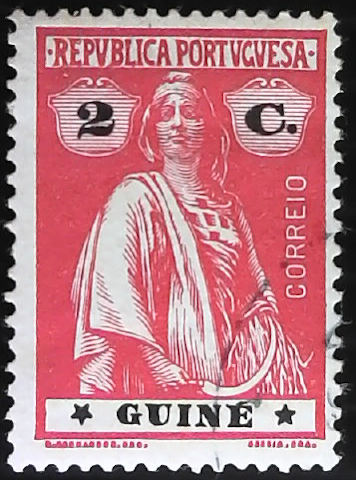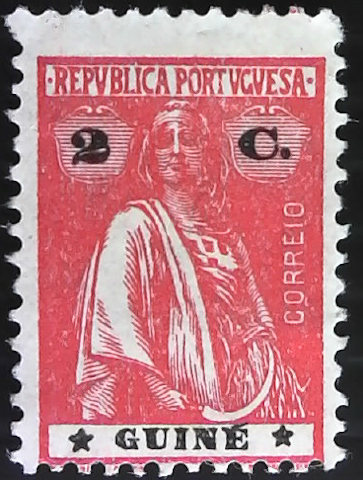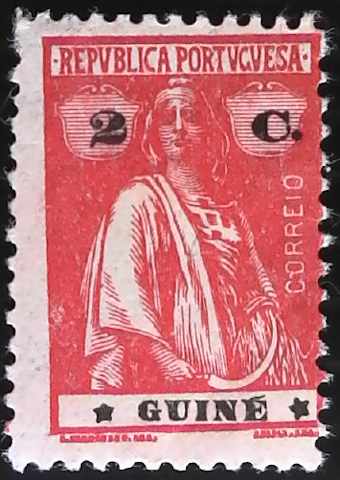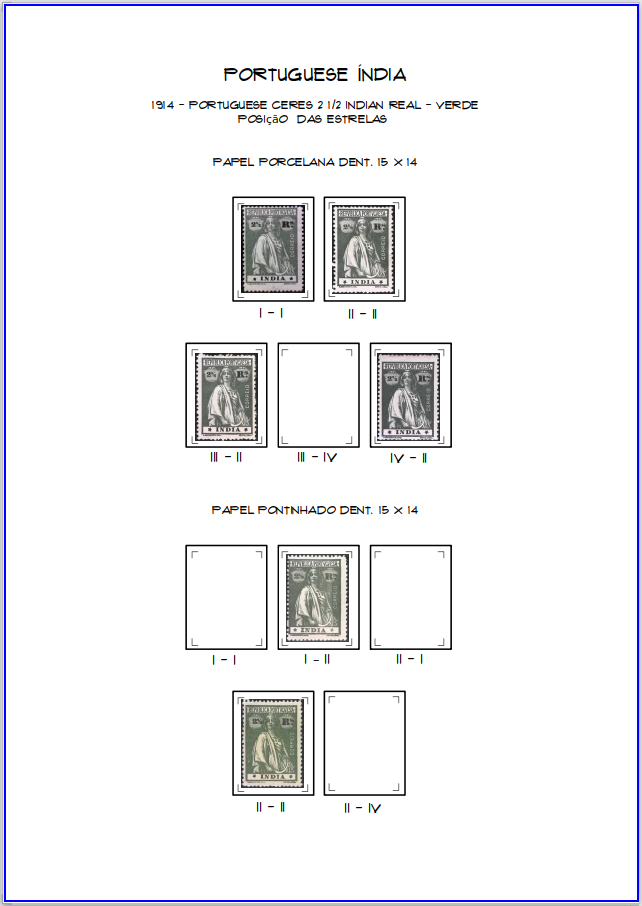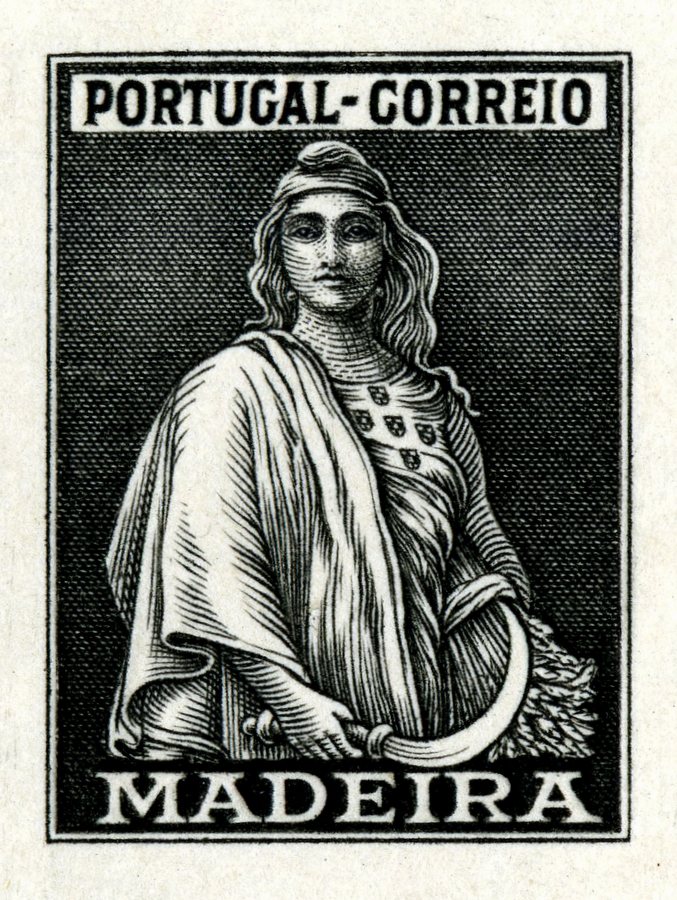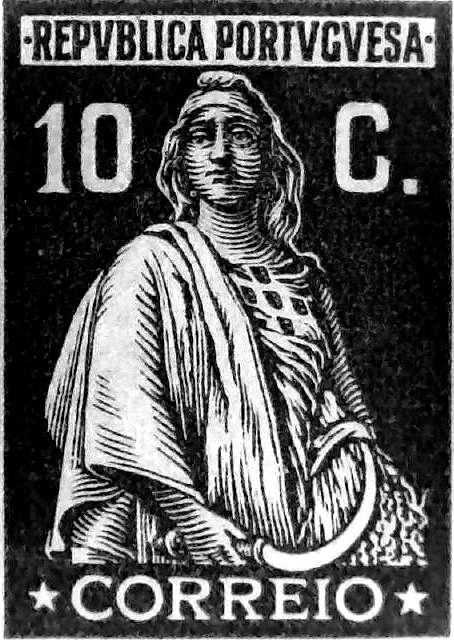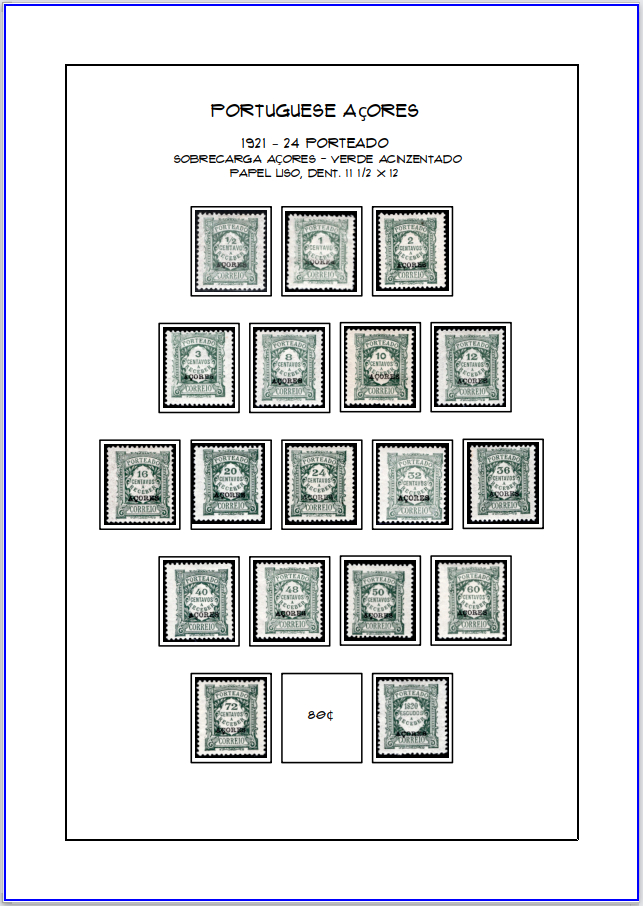stanley64
Member 
Posts: 1,978
What I collect: Canada, USA, Netherlands, Portugal & Colonies, Antarctic Territories and anything that catches my eye...
|
Post by stanley64 on Feb 15, 2020 11:09:50 GMT
With this most recent posting, I thought to take a moment and share a thought or two about the Portuguese Ceres collection and its beginnings, current state and future. I, like some other collectors here on the Forum, just like to jump into the deep-end and begin a new collection. For my Ceres collection, the process was no different; I purchased two small collections at auction in what I refer to as my "starter". Subsequently, I have added to this initial accumulation of the Portuguese Ceres issues the purchases of several complete or partial sets. With some knowledge and a basic catalogue, I was able to get so far but the values, shades, perforations, stars, etc. and although somewhat covered in my basic world catalogue of 1944, the information was rudimentary at best and I needed more if I was going to successfully build a worthwhile collection. So in order to increase my knowledge, I purchased a couple of reference or specialised texts that allowed me to further my understanding from the work of others and gave me a springboard so that I could advance the initial collection. In short, it was the discussions of the French Sower or local German issues here on TSF that were the encouragement for my undertaking the formation of a Portuguese Ceres collection and if that were not enough, there was also the Big Blue blog maintained by @ jkjblue that provided additional incentive. As quoted from his blog, “I would think that if I was specializing in the Portuguese colonies, I would pick the "Ceres" issues to study engraving changes, perforations, color, paper, postmarks, and postal history. What ... fun that would be”. Indeed, it has been just that; I am having a blast with this series and would encourage others to explore similar issues from the same time period, if not the Portuguese Ceres issues themselves ;-)
São Tomé and Príncipe 5 C. Ceres Issue (1914 - 1922) Afinsa nº 205. a. Deep Blue, perforated 15 x 14, paper porcelain (medium)
b. Bright Blue, perforated 12 x 11 1/2, paper pontinhado (vertical)
c. Clear Blue, perforated 12 x 11 1/2, paper pontinhado (vertical)
As mentioned in another thread, this is the decade of the Ceres issues and for now, like the colour of a 5 centavos São Tomé and Príncipe Ceres postage stamp, it is into the wide blue yonder... Happy collecting! |
|
stanley64
Member 
Posts: 1,978
What I collect: Canada, USA, Netherlands, Portugal & Colonies, Antarctic Territories and anything that catches my eye...
|
Post by stanley64 on Feb 20, 2020 16:10:15 GMT
Continuing with the Portuguese colonies, here is a 6 C. block from the 1922 issue of São Tomé e Príncipe (Afinsa No. 251) 12 x 11 1/2, lilac and printed on smooth (liso) paper. Now in addition to the 7th stamp containing cliché n.º CCLXIII, stamps 8 and 9 from the same row have almost identical clichés, cliché n.º CCCXL.
In stamps printed with engrave plates, re-entries & re-touches can often be attributed to a single position within the full plate itself, i.e. Canada's Imperial Penny Postage aka The Map Stamp of which many examples exist as in the thread here. However, given the occurrence of a similar cliché across multiple stamps of the Portuguese Ceres issues as shown in this example e.g. stamps 8 & 9, this does not appear to be the case for those stamps printed using the typography method.
The things that make you go hmmm....
Happy collecting!
|
|
stanley64
Member 
Posts: 1,978
What I collect: Canada, USA, Netherlands, Portugal & Colonies, Antarctic Territories and anything that catches my eye...
|
Post by stanley64 on Mar 14, 2020 10:53:21 GMT
In 1914, the then Portuguese colonies or territories issued sixteen stamp sets which followed the earlier Portugal issue of 1912 and its depiction of the Roman goddess Ceres.
These sets ranged in value from 1/4 Centavo to 1 Escudo and were printed on both chalk-surfaced paper (porcelena) and regular or smooth (liso) papers with perforations of 15 x 14 and 12 x 11 1/2 respectively.
Album page for the colony issues of 1914, e.g. Portuguese Tete
Happy collecting!
|
|
stanley64
Member 
Posts: 1,978
What I collect: Canada, USA, Netherlands, Portugal & Colonies, Antarctic Territories and anything that catches my eye...
|
Post by stanley64 on Mar 14, 2020 10:53:54 GMT
The highest value of each set in the 1914 issues was the 1 Escudo . Here are three examples all on porcelana paper and perforated 15 x 14:
Inhambane (Afinsa n.º 86), Lourenço Marques (Afinsa n.º 132) & Quelimane (Afinsa n.º 40),
Happy collecting!
|
|
stanley64
Member 
Posts: 1,978
What I collect: Canada, USA, Netherlands, Portugal & Colonies, Antarctic Territories and anything that catches my eye...
|
Post by stanley64 on Apr 20, 2020 16:01:57 GMT
As previously mentioned, the 1914 sets issued for the Portuguese colonies ranged in value from 1/4 Centavo to 1 Escudo and were printed on both chalk-surfaced paper (porcelena) and regular or smooth (liso) papers with perforations of 15 x 14 and 12 x 11 1/2 respectively. Below is a complete matched set of chalk-surfaced paper (porcelena) 15 x 14 from São Tomé and Príncipe.
1914 São Tomé and Príncipe - Afinsa nº 199 - 214.
The porcelana or chalk-surfaced papers shown here is one of several types of papers used in the printing of the Portuguese Ceres issues. It is a glossy paper, either medium or ordinary depending of the fibre weave, with a tight or compact texture and has a slight chalky layer on the surface that is easily discernible in unused copies. For confirmation though, the ordinary chalked-surface or porcelain paper has fibres that run vertically and if heat is applied, the stamp will curl or arch on the vertical axis. Whilst the medium chalked-surface has horizontal fibres and the stamp will arch on the longer sides under the same circumstances.
The heat source for detecting or confirming the paper-type can be one's hand or a low-wattage light bulb, but please not an open flame...
Happy collecting!
|
|
Beryllium Guy
Moderator 
Posts: 5,908  What I collect: Worldwide Stamps 1840-1930
What I collect: Worldwide Stamps 1840-1930
|
Post by Beryllium Guy on Apr 20, 2020 19:55:27 GMT
Vince ( stanley64), please permit me to thank you for this excellent thread and the great images you have posted in it. Well done to you! I am really enjoying it. I have professed to be a WW collector, and while I have some material from Portugal and her colonies, I admit that I do not know much about these stamps. I am trying to educate myself through your posts, and with a bit of luck, I will try to do more with my own holdings sometime in the future. At the moment, I do not have access to the bulk of my collection, which resides in California, while I am here in the UK. Still, I am not complaining.... In any event, I have an impertinent question for you! I really like your custom pages. As the sets have 16 stamps in them, which you have laid out in a very attractive 3-4-5-4-3 arrangement, what are the last three spaces for? Are there certain varieties that you may put there, or are the spaces there just to complete the symmetry of the pattern? Sorry if you explained this previously and I missed it, but I am just curious. I do love the pages in any case!    |
|
blaamand
Member  Currently creating custom pages until 1940.
Currently creating custom pages until 1940.
Posts: 1,459  What I collect: Worldwide - Stamps and Postmarks - not enough time...
What I collect: Worldwide - Stamps and Postmarks - not enough time...
|
Post by blaamand on Apr 21, 2020 9:23:02 GMT
stanley64 - Beautiful custom pages, as always, well done!  Cool, interesting you can use heat to detect orientation of the fibres, I did not know that. I've used slight moisture (by breathing on the reverse), but then the stamps need time to dry after before going into the mounts. If using heat does the same thing, that waiting time wouldn't be needed - which is great! Thanks, learning something every day on this forum 
|
|
stanley64
Member 
Posts: 1,978
What I collect: Canada, USA, Netherlands, Portugal & Colonies, Antarctic Territories and anything that catches my eye...
|
Post by stanley64 on Apr 21, 2020 10:57:41 GMT
Thanks Chris ( Beryllium Guy ) glad to hear you are enjoying the pages. I started this thread at the beginning of the year to document my experience of collecting the Portuguese Ceres issue and like you, I am learning a lot. This was the world's longest running definitive series (1912-1931) and there is plenty of material to explore. A fair bit of territory has been covered to date in the different postings and the intention is to complete an overview of a basic Ceres collection with a few more posts.
Regards the page layout, at this time it is purely aesthetics as it does give the page(s) a certain balance or symmetry as you suggest.
Initially the thought was to have the extra spaces for displaying examples with different paper types, clichés, etc., but given the material available including the larger blocks, I have created separate pages for them.
cliché n.º CCLXIII cliché n.º CCCXL
As well, for some of the issues and to your point shared in another thread, the visual appeal of an entire page of stamps produced with porcelana paper that are nicely centered and having good color is striking! At the same time, creating these sets has allowed for the creation of other pages that are dedicated to different paper types, perforations, etc.
Recently I did see an exhibit of the issue with its pages based on the denomination of the stamp rather than time period e.g. a page dedicated to the 1C. Green, so they are subject to change.
For the time being though the extra spaces will remain, if not just for symmetry...
Happy collecting!
|
|
blaamand
Member  Currently creating custom pages until 1940.
Currently creating custom pages until 1940.
Posts: 1,459  What I collect: Worldwide - Stamps and Postmarks - not enough time...
What I collect: Worldwide - Stamps and Postmarks - not enough time...
|
Post by blaamand on Apr 21, 2020 15:22:10 GMT
stanley64 - Spectacular block and varieties  Hmmm, I believe the Posthorn's (Norway) is unrivaled ? It's been around since 1871 - and is still sold at the post offices
|
|
stanley64
Member 
Posts: 1,978
What I collect: Canada, USA, Netherlands, Portugal & Colonies, Antarctic Territories and anything that catches my eye...
|
Post by stanley64 on Apr 21, 2020 17:57:09 GMT
Here is the full block of twelve; a little hard to see the clichés though,
As for the longest-running definitive sets, the Portuguese Ceres were valid for postal service from February 1912 until August 1931, and then again from January 1934 until September 1945 or more than thirty years.
From the link you shared, I read that the Norwegian Posthorn was "After 91 years, the Post Horn design was revised in 2001..." What was the time period for the initial 1871 issues?
Not quite ready to given up the record on behalf of the Ceres issue, but it could be my reference material is out-of-date...
Happy collecting! |
|
blaamand
Member  Currently creating custom pages until 1940.
Currently creating custom pages until 1940.
Posts: 1,459  What I collect: Worldwide - Stamps and Postmarks - not enough time...
What I collect: Worldwide - Stamps and Postmarks - not enough time...
|
Post by blaamand on Apr 22, 2020 9:47:55 GMT
Yes, unfortunately I think your reference is not correct. I agree the Ceres are wonderful, but you'll find many references acknowledging the posthorns as the longest running series. Posthorns have been on sale at the Post offices continuously from 1871, starting with the first issue in 'skilling' currency. Can't remember exactly how long the 'skilling' stamps remained valid after the change of currency to kroner/øre, but it doesn't really matter, the design has remained virtually unchanged for 149 years now, only minor and gradual change in the fonts, printing techniques, papers etc. If still curious, here's a few references (in addition to the one already shared yesterday): Quote from WOPA link"The posthorn series is the world’ s longest running series of stamps and has garnered a lot respect since the first 3-skilling stamp was issued. Norway Post is continuing the tradition and Norway has a world record that will most likely never be surpassed!" Quote from this site link: "...with very few minor variations, the design of that stamp is still being used today making it the longest-running stamp issue ever. When you have a perfect design, why change it?" With more details of all the minor changes kindly provided by vikingeck in 2010, ref this link to another forum"....the post horn design is the world's longest running stamp design having been issued since 1871. It has undergone small changes in style over the years" |
|
vikingeck
Member 
Posts: 3,546
What I collect: Samoa, Tobacco theme, Mail in Wartime, anything odd and unusual!
|
Post by vikingeck on Apr 22, 2020 10:39:42 GMT
Thanks for reminding me blaamand it was 10 years since I posted that list on that other stamp board ( which I left in anger at abusive and inaccurate comments from one who shall remain nameless) However as to the Ceres being the longest running definitive they have long been out stripped by the GB Machin heads, decimal since 1972 and pre decimal before that. Well over 50 years now,! But still second to the Norway Post-horns |
|
|
|
Post by sherro on Apr 22, 2020 10:58:36 GMT
Thanks for reminding me blaamand it was 10 years since I posted that list on that other stamp board ( which I left in anger at abusive and inaccurate comments from one who shall remain nameless)     |
|
|
|
Post by sherro on Apr 22, 2020 11:05:59 GMT
Vince, I love that font you're using!
|
|
stanley64
Member 
Posts: 1,978
What I collect: Canada, USA, Netherlands, Portugal & Colonies, Antarctic Territories and anything that catches my eye...
|
Post by stanley64 on Apr 22, 2020 14:06:34 GMT
I appreciate the input blaamand, vikingeck and for setting the record straight; all good!
Alas, the Ceres issue has been knocked from the first tier, down to the third, but hopefully not completely off the podium and perhaps if one considers consistency or continuous use of the same design, the Ceres can once again take the top step! But I digress and given the current company, I trust that my comments have not been construed as being inaccurate or malicious ;-)
Happy collecting!
|
|
stanley64
Member 
Posts: 1,978
What I collect: Canada, USA, Netherlands, Portugal & Colonies, Antarctic Territories and anything that catches my eye...
|
Post by stanley64 on Apr 22, 2020 14:36:14 GMT
For the Ceres issue and those specifically issued for the then colonies with shorter names, such as Congo, Guiné, Tete, etc. have stars placed on either side of the colony name.
The stars can be oriented up (Position n.º I ), down (Position n.º II), 45 degrees to the right (Position n.º III), or 45 degrees to the left (Position n.º IV). And each star, that being the left one and the right one can have their own orientation and do not need to match as in these examples,
Guiné 2 C. Ceres Issue (1914 - 1922) Afinsa nº 147.
a. Carmin, perforated 15 x 14, paper pontinhado (vertical) - star orientation II-II
b. Carmin, perforated 15 x 14, paper porcelain (medium) - star orientation II-I
c. Carmin, perforated 12 x 11 1/2, paper smooth - star orientation I-I
d. Carmin, perforated 12 x 11 1/2, paper smooth - star orientation I-III
Initially created as a counterfeit measure, the orientation of the stars can be considered both in terms of "normal" configuration along with the exceptions or variants...
Happy collecting!
|
|
stanley64
Member 
Posts: 1,978
What I collect: Canada, USA, Netherlands, Portugal & Colonies, Antarctic Territories and anything that catches my eye...
|
Post by stanley64 on Apr 22, 2020 14:43:44 GMT
Just as variations of the star orientation exist for the Guiné issues, they also exist for other short names Portuguese colonies as well,
Happy collecting!
|
|
blaamand
Member  Currently creating custom pages until 1940.
Currently creating custom pages until 1940.
Posts: 1,459  What I collect: Worldwide - Stamps and Postmarks - not enough time...
What I collect: Worldwide - Stamps and Postmarks - not enough time...
|
Post by blaamand on Apr 22, 2020 17:15:29 GMT
Great post about the star orientations! I collect them to, makes for an interesting study, and yet quite straightforward when having a good reference, eg Afinsa. Unlike many other varieties, that might be difficult to identify or having grey-zones, the star varieties are great because they are so easy to identify with certainty. Keep them coming, love your thread stanley64! |
|
blaamand
Member  Currently creating custom pages until 1940.
Currently creating custom pages until 1940.
Posts: 1,459  What I collect: Worldwide - Stamps and Postmarks - not enough time...
What I collect: Worldwide - Stamps and Postmarks - not enough time...
|
Post by blaamand on Apr 22, 2020 17:27:10 GMT
I trust that my comments have not been construed as being inaccurate or malicious ;-)
No worries, certainly not.
And forgive me for 'defending' my own countries stamps. I felt obliged to, because beyond the classical beauty of the 'Oscars' and the endurance of the Posthorns, there's really not much else in Norwegian stamp issuing history to be bragging about at all, hahaha. Personally I even find the Posthorns rather boring!
|
|
stanley64
Member 
Posts: 1,978
What I collect: Canada, USA, Netherlands, Portugal & Colonies, Antarctic Territories and anything that catches my eye...
|
Post by stanley64 on Apr 22, 2020 17:53:32 GMT
It is all good blaamand and I figured as much, but just making sure. Interestingly enough - national pride, winner's podium, etc., puts stamp collecting or philately at level pegging with the likes of a FIFA play-off match ;-)
Glad to see someone else collecting stars as they are fun and as you say, relatively straightforward...
Happy collecting!
|
|
|
|
Post by michael on Apr 25, 2020 8:32:52 GMT
I have some interest in the Ceres series as Perkins Bacon recess printed the 1929 issue for Madeira. 21 colourful values:  Most interesting for me is that Wikipedia, Linns and the Scott catalogue says they are from 1928. From Scott: "It was obligatory to use these stamps in place of those in regular use on May 1, June 5, July 1, and Dec. 31, 1928, Jan. 1 and 31, May 1, and June 5, 1929. The ammount obtained form this sale was donated to a fund for building a museum" They certainly were in aid of the Funchal museum but I have found that the die for these stamps wasn't engraved until 13th December 1928 and the first stamps were not printed until 25th December so they couldn't have been available on any of the above dates in 1928. In fact the Stanley Gibbons catalogue is the only one that is correct as they give a date of 1929 and that it was available on some days but doesn't say which ones. Would love to know the story behind this and which dates they were actually obligatory to be used on. Also, are there any others in the Ceres series that were recess printed? |
|
blaamand
Member  Currently creating custom pages until 1940.
Currently creating custom pages until 1940.
Posts: 1,459  What I collect: Worldwide - Stamps and Postmarks - not enough time...
What I collect: Worldwide - Stamps and Postmarks - not enough time...
|
Post by blaamand on Apr 25, 2020 12:13:11 GMT
michael - That's a gorgeous set, really vivid colors. And I need to correct my DIY page to 1929....  , thanks for letting us know
|
|
stanley64
Member 
Posts: 1,978
What I collect: Canada, USA, Netherlands, Portugal & Colonies, Antarctic Territories and anything that catches my eye...
|
Post by stanley64 on Apr 25, 2020 14:54:53 GMT
Always great to see someone else share an interest in the Ceres series, thanks for posting michael!
From my own references, the Madeira issues printed by Perkins, Bacon & Co. Ltd., London had an issue date of 1929-05-01. This date does collaborate the engraving and printing dates you have already shared. Valid postal dates for their use would have been from the issue date on, but it was obligatory to use them on 31 January, 1 May & 8 June 1929 for the fund-raising effort mentioned.
To my knowledge, this issue and the London Ceres set posted earlier here are the only two not printed by the state-run Casa da Moeda and as well, the Madeira issues are the only set completed using the recess-printing method; the others were either printed using the letterpress process or in the case of the London issues, the lithographic technique.
If I come across additional details, I will happily share...
Happy collecting!
|
|
|
|
Post by michael on Apr 26, 2020 8:03:28 GMT
Thanks blaamand and stanley64 for your comments. Useful to know it is the only recessed version, will add that to my write-up. My album page also still says 1928, need to redo  . The stamps were printed 10 x 10 and there were 2 plates. Would like to to compare the design with the other London version, does anyone have a high res. scan of a mint copy? Here's the engraved version as a plate proof:
|
|
stanley64
Member 
Posts: 1,978
What I collect: Canada, USA, Netherlands, Portugal & Colonies, Antarctic Territories and anything that catches my eye...
|
Post by stanley64 on May 8, 2020 14:58:29 GMT
Excuses for the delay michael , but here is a copy of the 10C. London Ceres originally in carmine,
If you need a higher resolution image than this one, let me know and I will see what I can find on-line...
Happy collecting!
|
|
|
|
Post by michael on May 13, 2020 19:50:15 GMT
Thanks for that stanley64 . Very interesting to see the differences. You might be iterested to know that Stanley Gibbons are bringing out the 1st Edition of a Portugal and Colonies Stamp Catalogue in 2020. It was schedueld for the 2nd quarter but obviously might be delayed now. |
|
|
|
Post by marking on May 13, 2020 22:17:26 GMT
Send PM with email if interested Listing (25 pages) on the dates, quantities, papers etc. and common specs (no plate variations or flaws)  |
|
stanley64
Member 
Posts: 1,978
What I collect: Canada, USA, Netherlands, Portugal & Colonies, Antarctic Territories and anything that catches my eye...
|
Post by stanley64 on May 14, 2020 6:57:42 GMT
Any attention from the larger houses, be their auction, publishing or otherwise can only be a good thing for the collectors of Portugal and the colonies.
Happy collecting! |
|
stanley64
Member 
Posts: 1,978
What I collect: Canada, USA, Netherlands, Portugal & Colonies, Antarctic Territories and anything that catches my eye...
|
Post by stanley64 on Jun 9, 2020 12:24:49 GMT
This thread was started at the beginning of the year and although there is still more than can be shared with regards to the Portuguese Ceres issues and I will continue to collect the series, I am going to wrap up this one up for summer and end with these Postage Dues from the same era,
Postage Due Stamps of Portugal Overprinted in Black - AÇORES (1921 - 24) Afinsa nº 22/40
My enthusiasm continues and since starting I have added to the collection of Portugal's Ceres stamps including those from the islands & former colonies. At the same time, there a few more books on the library shelf as a result including those written by Sr. J. Miranda da Mota that have proven to be an invaluable source of information.
This is a great series that can be full of fun and adventure with its various printings, papers, perforations, clichés, along with even a star or two and I would encourage anyone with similar interests to spend some time with these issues...
Happy collecting!
|
|
stanley64
Member 
Posts: 1,978
What I collect: Canada, USA, Netherlands, Portugal & Colonies, Antarctic Territories and anything that catches my eye...
|
Post by stanley64 on Jul 8, 2020 7:20:13 GMT
Filling in the gap; a bit of paper that arrived in this week's post,
With the addition of this stamp the set is complete. However, I do note though that several of the stamps appear to be on a thicker, more coarse paper.
Is creating a second set warranted, hmmm...
Happy collecting!
|
|
